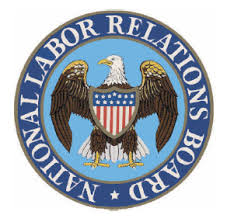 January 31 brought another announcement of a long-awaited federal relocation. Since 1993, the National Labor Relations Board (NLRB) has been headquartered at Franklin Court, on 14th Street in Northwest, D.C., but come December, the independent agency will move to the Capitol Riverfront district. The change reflects GSA’s ongoing efforts to shrink the federal footprint, in this case from about 247,000 SF to roughly 143,000 SF. In a prospectus approved by Congress last year, the NLRB indicated plans for more efficient, flexible space use at a new location, reducing its office utilization rate from 179 USF to 130 USF per person. Combined with lower rental rates in Southeast, the smaller footprint for NLRB is estimated to save taxpayers $4.2 million over 10 years.
January 31 brought another announcement of a long-awaited federal relocation. Since 1993, the National Labor Relations Board (NLRB) has been headquartered at Franklin Court, on 14th Street in Northwest, D.C., but come December, the independent agency will move to the Capitol Riverfront district. The change reflects GSA’s ongoing efforts to shrink the federal footprint, in this case from about 247,000 SF to roughly 143,000 SF. In a prospectus approved by Congress last year, the NLRB indicated plans for more efficient, flexible space use at a new location, reducing its office utilization rate from 179 USF to 130 USF per person. Combined with lower rental rates in Southeast, the smaller footprint for NLRB is estimated to save taxpayers $4.2 million over 10 years.
From the 10-story, LEED-Gold building at 1015 Half Street, S.E., headquarters staff will continue to focus on the NLRB mission to safeguard private sector employee rights to join together to improve working conditions and wages, whether or not they belong to unions. A 5-member board and General Counsel govern the NLRB, all appointed by the president with consent of the Senate. The agency conducts elections for labor union representation and investigates and works to prevent unfair labor practices; in FY 2012, the agency handled 21,622 unfair labor practice cases and 2,646 representation cases. In addition to the D.C. headquarters, 32 regional offices support the NLRB mission, with a staff of 1680 employees and a FY 2014 budget request of $284.991 million.
Disruptive strikes and both union and employer violence in the 1930s led to the first federal legislation to protect collective bargaining rights for unions. In 1935, Franklin Roosevelt signed the National Labor Relations Act (NLRA), which designated the NLRB as the implementing agency. Roosevelt declared the purpose of the act to be improved relationships between labor and management, and believed it would encourage “the development of the employment contract on a sound and equitable basis.”
In early years, the agency endeavored to analyze the economic causes of labor unrest and uncovered evidence of millions spent by companies to spy on and undermine unions through armed strikebreakers and collusion with local law enforcement. But critics of the NLRB in the 1930s asserted that the agency was staffed with communists, and challenged the constitutionality of the NLRA. During World War II, the National War Labor Board displaced the NLRB as the focus of federal labor relations, and widespread strikes during and after the war led to major reforms of the NLRA known as the Taft-Hartley Act (officially, the Labor Management Relations Act of 1947). Crafted by anti-union Republicans and passed over President Truman’s veto, the reforms banned numerous types of strikes, required union officials to sign an anti-Communist oath, allowed states to pass their own right-to-work laws and enumerated new employer rights. Significantly, Taft-Hartley also banned the NLRB from collecting economic data or engaging in dispute mediation. In addition, the agency’s general counsel was separated from the board, so that the counsel would be responsible for investigating and prosecuting unfair labor claims before the adjudicating board. To bring charges, parties file against a union or employer with an appropriate regional director, who is the General Counsel’s delegated complaint authority. The charges are then investigated, and the General Counsel decides whether or not the case has merit. More than 90% are settled without formal litigation.
In a July 2, 2013, press release, NLRB Chairman Mark Gaston Pearce applauded the 78th anniversary of the NLRA. Especially in these tough economic times, said Pearce, the NLRB “is proud of our on-going work to guarantee democracy in the workplace and sustain a strong and expanding middle class.” The job certainly hasn’t been easy. Filling the 5-member board has been a tug-of-war between both the Bush and Obama administrations and Congress. In 2012, President Obama announced three recess appointments, despite Republican efforts to block such action by holding pro forma sessions throughout the break. Critics attacked the appointments as unconstitutional, a view upheld by the D.C. Circuit Court of Appeals, and the Supreme Court heard oral arguments on the issue on January 14. Their ruling will have implications for presidential powers of as well as for the NLRB.
Even though Congress confirmed all five of Obama’s nominees for the NLRB in July of 2013, a Supreme Court ruling could invalidate hundreds of NLRB rulings made by Obama’s recess appointees. The uncertainty weighs on employers and employees alike. “Regardless of whether you’re in the business community or organized labor, you want to know that the agency is operating with legal authority,” Steven Bernstein, a labor lawyer who represents employers, told The Washington Post. Said Bernstein, “You want to get it right the first time and make the results stick so you don’t face the possibility of waking up and doing it all over again.” Even as the NLRB starts packing boxes for the relocation to Half Street, it will be hard to move forward if stacks of invalidated cases land on their desks.
